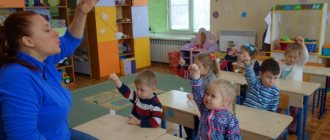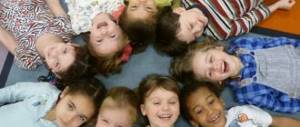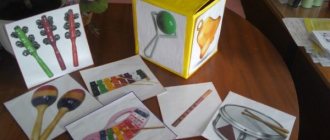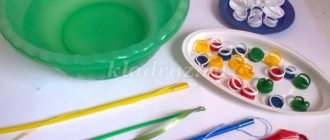Rules for conducting mathematical KVN and coming up with jokes for preschoolers
Such an event is a much more difficult task than it seems at first glance. The whole problem is that the humor of children and the humor of adults are two completely unrelated categories.
Note! The best solution to this problem would be to replace humor with some other amateur activity, say, theatrical skits or songs.
This will make it much easier to create joke math problems for preschoolers. Children will be able to prepare such work together with their parents, gathering at each other’s houses (of course, if the math quest was originally planned to be carried out in the older group).
How children dance in kindergarten in a playful way and with an accelerated tempo
Note! It is imperative to ensure that there is no inequality between children, and that sufficient time is given to everyone.
It is better to leave the humorous part of the event entirely in their care. It should be remembered that it should be funny for the main participants of the holiday, and not for the parents and teachers who have gathered to watch them. A moment that is humorous for adults may not be funny for children.
At such an event, a child will be able to solve even the most difficult problem for him.
Quest game on FEMP. Counting to 20. Preparatory group
Quest game on FEMP on the topic “Journey to sea inhabitants”
Completed by: Olesya Valerievna Sushkova, teacher of MDOBU kindergarten No. 105, Sochi. Relevance : this material will be of interest to kindergarten teachers and parents for the development of mathematical abilities. Goal: development of mathematical abilities through a selection of mathematical games. Objectives : 1. Consolidate counting to 20. 2. Development of logical thinking. 3. Consolidation of the ability to analyze and make mathematical conclusions. Attributes: presentation on the topic of the week, cards with tasks. PROGRESS OF THE LESSON: Educator : Hello, guys! Today we will go on an exciting journey! And where exactly you will find out by guessing my riddle: In the sea, only under water, You can meet the land. There are starfish, pebbles and sand here. Somewhere nearby there is a menacing, important octopus walking. And the lost ships are landing here. What is this, guys? (sea bottom). - That's right, guys, this is the seabed! But you and I, guys, will not just solve problems, but for the correct answer, collect parts of a very beautiful picture and find out who lives at the bottom of the sea. Are you guys ready to go on a journey? (yes) - Well, then be careful! Task 1. Find identical shrimps . Goal: it is necessary to find an absolutely identical pair from the offered shrimps with pictures. - Well done, here's part of our picture. Task 2. Find the fish here and count them? Goal: consolidation of counting and the ability to coordinate nouns. - Great, we did it. Here's the second part of the picture. - Now, let's play with our fingers. Finger game “Fish” The fish swims in the water, (It’s fun to play with the fish’s palms folded together. They depict how the fish swims.) Fish, fish, mischievous, (They shake their finger.) We want to catch you. (They slowly bring their palms together.) The fish arched its back, (Again they depict how the fish swims.) She took a bread crumb. (They make a grasping movement with both hands.) The fish waved its tail, (They “swim” again.) The fish quickly swam away. - Well done! Next Task 3. Find the right shadow. Goal: you need to find shade for the inhabitants of the seabed. — We earned the third part of the picture. — Task 4. Find what is missing. Goal: solving logical chains. - Well done boys. Once again, you've earned part of the picture. — Task 5. Solve the example and find a pair for the whale. Goal: strengthen the ability to solve examples on addition and subtraction. (It is necessary to connect whales with examples with whales with answers, solving the examples) - Well done! Another part of the picture. - Let's rest a little. Physical education “Fish” A fish lived in a lake, The fish swam to the shore, (feet shoulder-width apart, hands on the belt, bending to the sides),
wagged its tail, looked for food for itself.
(we jump our legs to the sides, together)
There is a worm near the shore, Wriggling like this,
(hands on the belt; we make circular movements with our hips to the left and right)
The fish swims up, the worm is grabbed.
(separate the wrists and connect them)
The fishermen pulled the line, but the worm fell off,
(clap our hands in front of the chest and behind the back)
The fish was not caught, but the worm was left.
(we make wave-like movements with our palms folded together: imitation of the movement of a fish)
- Well done, guys, take your seats.
— Task 6. Find a half for the fish. You get part of the picture. — Task 7. Find the right pebble for the crab. Goal: strengthen the ability to compare objects by size. - Guys, look, we have collected all the parts of our picture. Let's fold it and see how beautiful the underwater world is. — Did you like our unusual journey? (children's answers).
“You did a good job, and now I’ll give you coloring books and we’ll color them.” (At the end of the lesson, everyone is given a coloring sheet with a picture of the seabed.)
We recommend watching:
Mathematical quiz for children of the preparatory group of a preschool educational institution Mathematical games for children of the preparatory group on the topic: “Wintering birds” Didactic games on FEMP for preschoolers 5-7 years old Didactic manual made of felt on mathematics for children 5-7 years old with your own hands step by step with photos
Similar articles:
Games with numbers for children 6-7 years old
Didactic exercises for children 5-6 years old in mathematics in pictures
Counting tasks for children 6-7 years old
Tasks in pictures for children 6-7 years old






